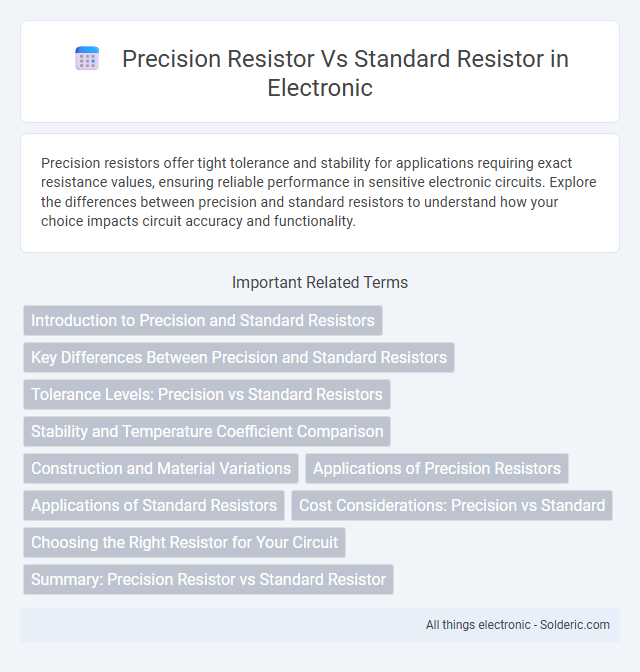Precision resistors offer tight tolerance and stability for applications requiring exact resistance values, ensuring reliable performance in sensitive electronic circuits. Explore the differences between precision and standard resistors to understand how your choice impacts circuit accuracy and functionality.
Comparison Table
| Feature | Precision Resistor | Standard Resistor |
|---|---|---|
| Tolerance | +-0.01% to +-1% | +-5% to +-20% |
| Temperature Coefficient | 5 to 50 ppm/degC | 100 to 500 ppm/degC |
| Stability | High, minimal drift over time | Moderate, higher drift over time |
| Applications | Calibration, measurement, instrumentation | General electronics, consumer devices |
| Cost | Higher | Lower |
| Power Rating | Typically up to 1W | Varies, up to several watts |
Introduction to Precision and Standard Resistors
Precision resistors feature tight tolerance levels, often within +-0.1% or better, ensuring highly accurate resistance values critical for applications requiring reliable performance and minimal error margin. Standard resistors generally have wider tolerance ranges, such as +-5% or +-10%, making them suitable for less sensitive electronic circuits where cost efficiency is prioritized over exact resistance. The choice between precision and standard resistors depends on the required accuracy, stability, and environmental factors in the circuit design.
Key Differences Between Precision and Standard Resistors
Precision resistors offer tight tolerance levels typically around +-0.1% or better, whereas standard resistors usually have tolerances of +-5% or +-10%. Precision resistors exhibit lower temperature coefficients and enhanced stability, making them ideal for applications requiring accurate and consistent resistance values. Standard resistors are generally cost-effective and suitable for general-purpose uses where exact resistance values are less critical.
Tolerance Levels: Precision vs Standard Resistors
Precision resistors offer extremely low tolerance levels, typically ranging from +-0.01% to +-0.1%, ensuring highly accurate resistance values. Standard resistors generally have tolerance levels around +-5% to +-10%, which accommodates wider variation and less precise applications. Choosing precision resistors can significantly improve the reliability and performance of your electronic circuits when exact resistance values are critical.
Stability and Temperature Coefficient Comparison
Precision resistors offer significantly enhanced stability and lower temperature coefficients compared to standard resistors, ensuring minimal resistance variation over time and temperature changes. Typical precision resistors have temperature coefficients as low as +-5 ppm/degC, whereas standard resistors often exhibit values upwards of +-100 ppm/degC, impacting circuit performance under varying thermal conditions. Selecting precision resistors improves accuracy and reliability in temperature-sensitive applications where your design demands consistent resistance values.
Construction and Material Variations
Precision resistors utilize tightly controlled materials such as metal film or metal oxide to ensure minimal tolerance and stable resistance values, while standard resistors often use carbon film or carbon composition, leading to broader tolerance ranges. The construction of precision resistors involves advanced layering techniques and protective coatings that enhance temperature stability and reduce noise, whereas standard resistors have simpler constructions prone to higher variability under environmental changes. These material and construction differences result in precision resistors providing superior performance in applications demanding high accuracy compared to standard resistors.
Applications of Precision Resistors
Precision resistors are essential in applications requiring high accuracy and stability, such as medical devices, instrumentation, and aerospace systems where precise measurements are crucial. They are used in calibration circuits, sensor signal conditioning, and high-frequency communication equipment to ensure consistent performance and low tolerance errors. Their tight tolerance and low temperature coefficient make them ideal for precision voltage dividers and feedback loops in operational amplifiers.
Applications of Standard Resistors
Standard resistors are commonly used in general-purpose electronic circuits where high accuracy is not critical, such as in consumer electronics, power supplies, and basic signal processing. They are suitable for applications requiring cost-effective solutions with tolerance levels typically ranging from +-5% to +-20%. Standard resistors are ideal for environments with less stringent stability and precision demands, including LED circuits, pull-up/pull-down configurations, and simple voltage division.
Cost Considerations: Precision vs Standard
Precision resistors typically cost significantly more than standard resistors due to tighter tolerance, higher stability, and better temperature coefficients that ensure accurate performance in critical applications. You must weigh the cost-benefit ratio, as standard resistors offer economical solutions for general purposes where exact resistance values are less critical. Choosing precision resistors increases upfront expenses but reduces long-term errors and potential rework costs in sensitive electronics.
Choosing the Right Resistor for Your Circuit
Precision resistors offer tighter tolerance levels, often as low as +-0.1%, ensuring exact voltage and current control in sensitive circuits, whereas standard resistors typically have +-5% tolerance, suitable for non-critical applications. Your choice depends on the required accuracy and stability of the circuit, with precision resistors ideal for high-accuracy analog and measurement systems. Consider factors like temperature coefficient, power rating, and noise performance to select the resistor that best matches your design specifications.
Summary: Precision Resistor vs Standard Resistor
Precision resistors offer tighter tolerance levels, typically +-0.1% or better, ensuring accurate resistance values for critical applications, whereas standard resistors generally have +-5% tolerance, suitable for general use. They provide enhanced stability, low temperature coefficients, and reduced noise, making them ideal for precision circuits like instrumentation and measurement devices. Standard resistors are cost-effective and widely available but lack the exactness needed for high-accuracy performance in sensitive electronic equipment.
Precision resistor vs standard resistor Infographic

 solderic.com
solderic.com